Understanding Rat Chewing Behavior in Homes
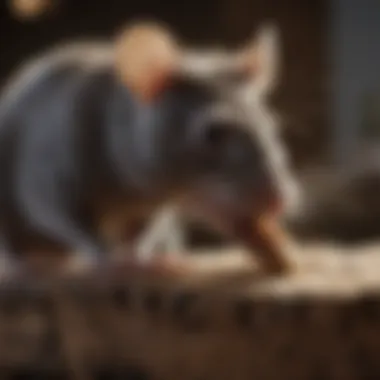
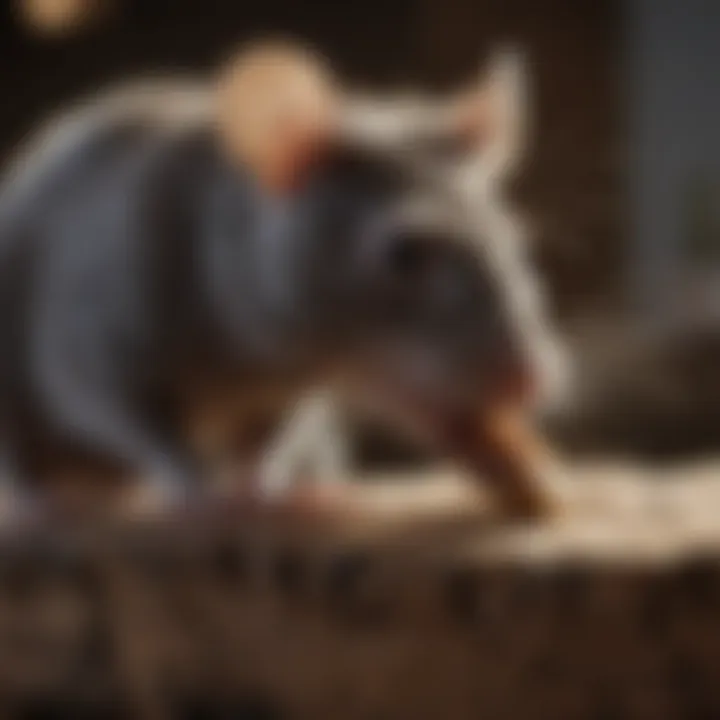
Intro
Understanding rat chewing behavior is vital for pet owners and anyone interested in domestic environments where these rodents live. This behavior serves various functions and has significant implications for households. Rats, as pets or inhabitants in our homes, display chewing that can be attributed to both instinctual and environmental factors. Knowledge about this phenomenon can be crucial in fostering a functional coexistence with these creatures and maintaining a well-ordered domestic space.
Understanding Your Pet
Pet Behavior Basics
Rats are naturally curious animals. Chewing is a fundamental behavior observed in rats and much of it is driven by their need to explore their environment. This instinct not only aids in their survival, but also fulfills a sensory requirement. Chewing helps them wear down their continuously growing teeth. Failure to address this can lead to serious dental problems.
Common Breed Characteristics
Different breeds have distinct characteristics impacting their chewing behavior. For example, Dumbo rats tend to be more social and interactive than other breeds, influencing their need for exploration. Hooded rats, on the other hand, can be more cautious. Understanding these nuances is important for managing their chewing behaviors effectively.
Species-Specific Needs
As domesticated animals, rats still retain their wild instincts. They require stimulation and opportunities to gnaw. It's important for pet owners to provide appropriate objects for chewing. Items like untreated wood, cardboard, and specially designed chew toys can satisfy their natural instincts while preventing them from damaging household items.
Pet Care and Maintenance
Feeding Guidelines
A proper diet plays a key role in maintaining a rat’s health. High-quality pellets, fresh fruits, and vegetables constitute a balanced diet. Over-indulgence in sugary items can lead to obesity, prompting more destructive chewing behavior as a means of stress relief.
Grooming Essentials
While rats are relatively low-maintenance, they do benefit from occasional grooming. Regular handling can help breed familiarity and reduce stress. Additionally, cleaning their enclosure often can encourage better habits by providing a cleaner environment conducive to healthy behavior.
Hygiene Practices
Keeping a clean environment significantly reduces undesirable behaviors. A well-maintained cage limits odors and encourages positive behaviors. A routine cleaning schedule should be followed, including replacing bedding and removing uneaten food.
Training and Development
Basic Commands and Skills
Training rats can be rewarding. Use positive reinforcement to encourage desired behaviors. Simple commands, like coming when called, can enhance communication between pets and their owners.
Behavioral Training Techniques
Behavioral issues often arise from boredom or stress. Implementing structured playtime and introducing novel objects can alleviate unnecessary chewing. Ensure training sessions are short and engaging to maintain the rat's focus.
Addressing Common Behavior Issues
Common challenges include destructive chewing and aggression. Monitor your pet's environment and eliminate triggers. Providing enrichment is key in addressing these issues, minimizing undesirable behavior through mental stimulation.
Health and Wellness
Routine Vet Check-ups
Routine veterinary visits are essential for identifying health concers early. Regular check-ups ensure your rat is healthy and that their chewing behavior is not linked to underlying issues, such as dental pain.
Vaccination Needs
While not all rats require vaccinations, discussing health needs with your veterinarian is vital. Understanding your pet's specific needs contributes to overall wellbeing.
Recognizing Signs of Illness
Early detection of sickness enhances outcomes. Common signs include lethargy, changes in appetite, or alterations in chewing habits. Monitoring your rat closely can lead to proactive health management.
Enrichment and Activities
Indoor vs. Outdoor Activities
Rats can thrive indoors, but outdoor time under supervision can provide additional stimulation. When engaging in outdoor play, ensure the environment is safe, and watch for potential hazards.
Interactive Toys and Games
Investing in interactive toys can divert chewing from household objects to appropriate items. Chew-friendly toys designed specifically for rats encourage healthy habits and provide mental stimulation.
Socialization Opportunities
Socializing your rat with other animals or humans can foster positive behavior. Supervised interaction helps develop social skills and reduces anxiety, which may reduce compulsive chewing tendencies.
Chewing behavior in rats is essential not only for dental health but also for mental well-being. Providing suitable alternatives is crucial for a harmonious coexistence.
Being proactive in understanding rat behavior is key for pet owners. Knowledge equips them to foster a more fulfilling and well-balanced life for their pets, ultimately leading to a safer and healthier living environment.
Prelims to Rat Chewing Behavior
Understanding rat chewing behavior is crucial for anyone involved in rodent care, especially in domestic settings. This behavior not only influences the health and well-being of the animals but also affects the environment they live in. Rats chew for various reasons, and recognizing these motivations can aid pet owners in managing their pets effectively.
The significance of this topic extends beyond mere curiosity; it encompasses aspects of pet ownership, safety, and psychological health of rats. When pet owners observe and understand chewing tendencies, they can create a more tolerant and equipped space for their pets. This awareness leads to more harmonious coexistence between humans and rats.
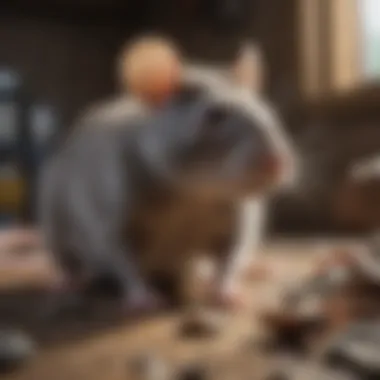
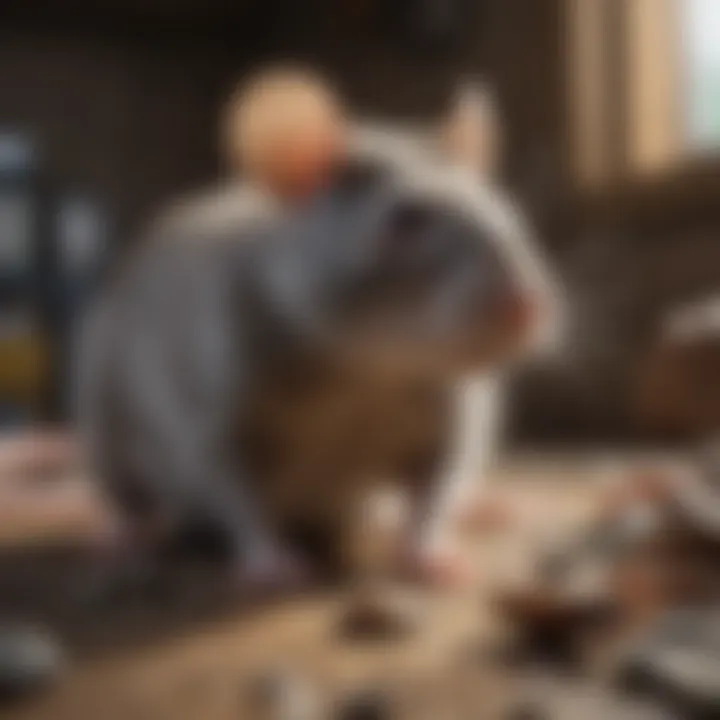
Several elements merit discussion in this article.
- Benefits of Understanding Chewing: Awareness can prevent potential damage to household items and vital fixtures. It can also reduce stress levels for both the rat and the owner.
- Considerations: By comprehending why rats chew, pet owners can create a safe environment, offer appropriate alternatives, and effectively navigate the frustrations that such behavior can cause.
- Management Techniques: Insights into this behavior can foster better management strategies, ensuring that the pet's natural instincts are satisfied without disrupting household harmony.
Thus, the exploration of rat chewing behavior is indispensable for fostering a safe and supportive environment conducive to rat welfare.
Understanding the Nature of Chewing
Rats are naturally inclined to chew. This chewing is an innate behavior essential for their survival and overall well-being. They possess continuously growing incisors which require constant wear to prevent overgrowth. In the wild, they must gnaw on various materials, including wood, roots, and other natural items, to keep their teeth in check.
In domestic settings, this behavior translates into a natural need to chew on items within the household. Pet owners may find their furniture or personal belongings becoming targets. However, viewing this behavior solely as destructive overlooks its underlying significance. Chewing serves multiple purposes, such as:
- Dental Health: Regular chewing is vital for maintaining dental health in rats. Without appropriate outlets, they risk harming themselves through tooth overgrowth.
- Exploration: Chewing allows rats to explore their environment. Through this behavior, they assess their surroundings, often revealing their curiosity and intelligence.
- Stress Relief: For many pets, chewing acts as a calming mechanism. Rats can experience stress, and chewing provides an outlet for them to alleviate this.
Recognizing these factors can help owners redirect their pet's chewing behavior toward acceptable items, minimizing damage while promoting a healthy lifestyle.
The Role of Chewing in Rat Physiology
The physiological aspects of rat chewing are significant in their life. Chewing is not merely a pastime but rather a critical activity fundamental to their health. As mentioned earlier, rats have incisors that grow continuously. This growth can pose risks if not managed through regular chewing.
Additionally, chewing aids in the following ways:
- Gastrointestinal Health: Chewing supports good digestive health by breaking down food into smaller particles. Rats are omnivorous, and their diet varies; thus, chewing helps prepare the food for digestion.
- Behavioral Conditioning: Chewing can play a role in shaping behavior. Rats that have access to chewable items may exhibit fewer destructive tendencies elsewhere, indicating that fulfilling their natural behaviors influences their overall disposition positively.
Overall, the roles played by chewing in rat physiology are profound, and acknowledging these roles assists owners in facilitating better care practices. Understanding why and how these animals chew not only enhances their environment but supports their general well-being.
Reasons Behind the Chewing Behavior
Understanding the reasons behind rat chewing behavior is essential for pet owners and those interested in domestic rodent care. Chewing is not a whimsical action; it serves numerous crucial functions in a rat's life. Recognizing these motivations allows owners to provide a better environment for their pets and take preventive measures against unwanted destruction.
Instinctual Behaviors
Rats, like many rodents, have strong instinctual urges to chew. This requirement is deeply rooted in their biology. The ever-growing teeth of rats need constant wear to prevent them from becoming too long. In the wild, this chewing behavior is a survival tactic that ensures their teeth remain functional for eating and other activities.
In domestic environments, this natural instinct manifests in various inappropriate chewing behaviors. Furniture, electrical cords, and even structural parts of a home often become targets. By understanding these inherent desires, pet owners can proactively search for appropriate alternatives. Providing safe chew toys can help satisfy this instinct while reducing damage to household items.
Environmental Influences
The environment plays a significant role in shaping rat behavior, including their chewing habits. Rats are curious creatures and often explore their surroundings by chewing. Factors such as confinement, lack of mental stimulation, or insufficient space can exacerbate the urge to chew on unsuitable items. If rats do not have adequate space to roam and explore, they may venture into places they shouldn’t.
Moreover, a cluttered and disorganized environment can lead to increased anxiety and stress for the rat. Consequently, a stressed rat is more likely to engage in destructive chewing as a form of coping mechanism. Therefore, maintaining a clean, organized space, and allowing for exploration are critical steps that can mitigate unwanted chewing.
Nutritional Needs
A rat's diet greatly influences its chewing behavior. When nutritional requirements are not met, rats may turn to alternative sources, such as household items, to satisfy their need for chewing. Lack of dietary fiber can lead to discomfort and compel rats to chew more vigorously in an attempt to alleviate their discomfort.
A balanced diet rich in vegetables, grains, and rat-specific pellets can significantly reduce destructive chewing. Providing proper nutrition helps meet their physiological needs and decreases the likelihood of unwanted chewing. Additionally, offering treats that require chewing can serve dual purposes: dietary enrichment and a satisfying outlet for their chewing instincts.
Understanding these three components—instinctual behaviors, environmental influences, and nutritional needs—provides valuable insights into rat chewing behavior. By addressing these factors, pet owners can create a more harmonious living environment for themselves and their pets.
The Impact of Chewing on Household Items
Rats exhibit unique chewing behavior that can have significant effects on household items. Understanding the implications of this behavior is crucial for pet owners and families who share their homes with these rodents. By examining the various aspects of damage caused by rat chewing, it becomes clear that proactive measures are essential for preserving both property and health.
Damage to Furniture and Fixtures
Rats have a natural instinct to gnaw, which can lead to extensive damage in a domestic setting. They often target wooden furniture, skirting boards, and other fixtures. The scratching and chewing can mar surfaces and weaken structural integrity. This behavior can undermine the longevity of valuable items in the home, resulting in the potentially costly need for repairs or replacements.
Furthermore, the aesthetic appeal of a home can be compromised by unsightly chew marks. Regular inspections can help identify the extent of the damage early, enabling timely interventions to protect furniture and fixtures from irreparable harm.
Risks Associated with Electrical Cords
Electrical cords are particularly vulnerable to rat chewing. Damaged cords pose a serious safety threat. Exposed wiring can lead to electrical shorts or fires, risking not only property but also the safety of inhabitants.
Pet owners must be vigilant in securing these cords to minimize risks. It is advisable to use protective coverings or to run cords through raceways that make them less accessible to inquisitive rats.
Potential Health Hazards
The health implications of rat chewing behavior cannot be overlooked. Rats are known carriers of various diseases, and when they chew on household items, particularly food containers or surfaces, they can contaminate them. The droppings and saliva left behind can introduce harmful pathogens into living spaces, raising health concerns for residents.
For instance, salmonella and hantavirus are just two examples of diseases associated with rodent infestations. To minimize health hazards, it is essential to educate family members about cleanliness and hygiene when sharing living spaces with rats. Regularly sanitizing areas where rats are active can help prevent potential health risks.
In summary, the impact of rat chewing on household items encompasses a variety of dangers that reach beyond simple annoyance. Addressing issues such as damage to furniture, risks associated with electrical cords, and potential health hazards is vital for maintaining a safe and pleasant home environment. By understanding these factors, pet owners can take the necessary steps to mitigate threats and promote a more harmonious coexistence with their rodent companions.
Behavioral Management Strategies
Behavioral management strategies are crucial for pet owners who seek to mitigate the effects of rat chewing behavior within domestic environments. Understanding the significance of these strategies can lead to more harmonious living conditions for both rats and their owners. By implementing effective management techniques, pet owners can alleviate damage to household items while promoting a healthier environment for their pets.
Creating a Safe Space
Establishing a safe space for rats is essential for their well-being and can help minimize unwanted chewing. A secure environment provides rats with a sense of safety and confidence, which in turn reduces anxiety that might drive destructive behavior. To create such a space, consider the following:
- Dedicated Enclosure: Utilize a large, well-ventilated cage that allows for climbing, hiding, and nesting. This enclosure acts as a sanctuary where they can retreat and feel in control.
- Quiet Area: Locate the cage in a quiet part of the home, away from heavy foot traffic or loud noises. Stress can exacerbate chewing behavior, making a calm environment vital.
- Consistent Routine: Establish a routine that includes regular handling, playtime, and feeding. Predictability in their environment aids in reducing stress and fostering a relaxed state.
By allowing rats to feel secure, the likelihood of excessive or destructive chewing behavior diminishes.

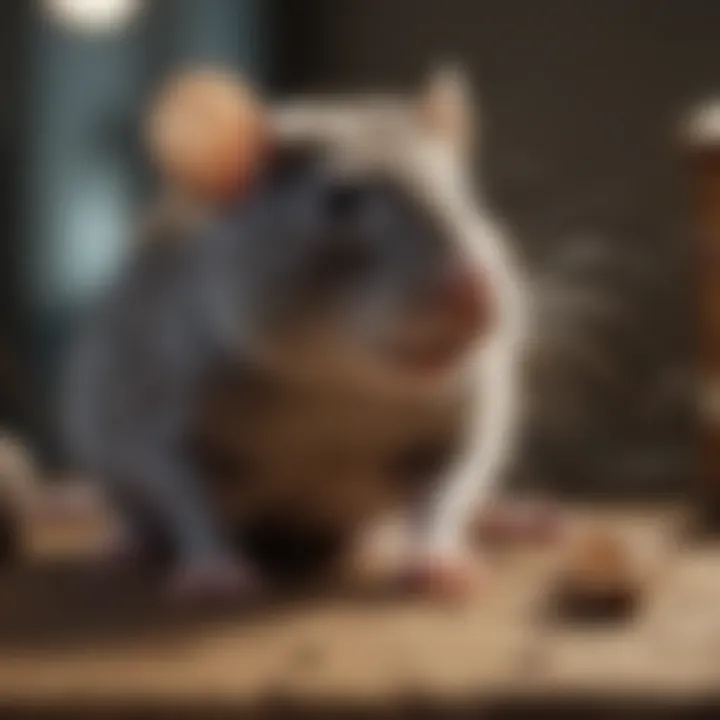
Appropriate Chew Toys
Providing appropriate chew toys is another effective strategy for managing rat chewing behavior. Chew toys serve not only as entertainment but also as essential tools for dental health. Rats have continuously growing teeth that need regular wear to prevent overgrowth and discomfort.
Here are various types of chew toys to consider:
- Natural Chew Materials: Look for items made from untreated wood, such as apple or willow branches. These materials can satisfy their chewing needs while being safe and less likely to splinter.
- Commercial Rat Toys: Opt for commercially available toys specifically designed for small rodents. These often incorporate interesting textures and designs that encourage natural chewing behavior.
- Homemade Options: Sometimes, simple household items can serve as chew toys. Cardboard tubes from toilet paper or soft blankets can engage rats while ensuring they do not turn to furniture or cords.
Offering appropriate toys minimizes the risks of destructive chewing while promoting health and happiness.
Positive Reinforcement Techniques
Positive reinforcement techniques can play a significant role in shaping rat behavior. This approach relies on rewarding desired actions which increases the likelihood of those behaviors being repeated. When addressing chewing behavior, consider the following:
- Reward Good Behavior: Whenever rats chew on their designated toys rather than household items, offer treats or praise. This reinforces the idea that chewing toys is acceptable and encourages them to make the right choice.
- Timing is Key: Ensure that rewards are given immediately after the desired behavior to create a clear connection in the rat's mind between the action and the reward.
- Gradual Conditioning: Over time, rats can be trained to transfer their chewing habits to more appropriate items by consistently rewarding them. This can reduce the occurrence of unwanted chewing significantly.
Effective behavioral management is not about punishment; it’s about creating a positive learning environment for your rat.
Preventive Measures for Pet Owners
The significance of preventive measures for pet owners cannot be overstated. Understanding how to mitigate the chewing behavior of rats is crucial for maintaining a harmonious household. Preventive actions not only protect household items but also enhance the well-being of the animals. Effective prevention strategies can lead to fewer conflicts with pets, ensuring a safe and pleasant living environment for both owners and their furry companions.
Securing Vulnerable Areas
Securing vulnerable areas in the home is an essential first step in managing rat chewing behavior. This involves identifying locations where rats may gain access to items that they could chew on, such as furniture, wires, and personal belongings. Common vulnerable areas include:
- Under kitchen sinks where plumbing may interest them.
- Behind appliances where food crumbs accumulate.
- Near electrical cords and outlets.
To secure these areas, owners should utilize barriers like baby gates or specialty coverings. Closing off access to these zones limits the rats' opportunities to engage in destructive chewing, thus preserving both the household items and the safety of the rats themselves.
Establishing Routine Checks
Establishing routine checks is another preventative measure aimed at controlling rat chewing behavior. Regularly inspecting the home allows pet owners to identify any new vulnerabilities or signs of chewing before they escalate. Owners should create a checklist of places to monitor, such as:
- The condition of furniture.
- Areas around cables and wires.
- Any areas where pets play frequently.
Conducting these checks not only helps in spotting potential issues but also reassures pet owners that their pets are safe. This proactive approach can prevent minor issues from turning into major damages, making it essential in rat ownership. Routine checks should be part of the weekly schedule and should be detailed enough to include any items showing wear or potential danger.
Utilizing Deterrents
Utilizing deterrents is a practical approach to minimize chewing behavior in rats. There are various types of deterrents available that can be effective against the urge to chew on undesirable items. These include:
- Taste deterrents: Applying a safe and bitter substance to surfaces that rats tend to target can dissuade them from chewing.
- Physical barriers: This includes wire mesh or plastic shields that can be placed over cables and wires to prevent access.
- Scent deterrents: Some scents, such as citrus, can deter rats naturally from certain areas or objects.
Integrating these deterrents requires understanding the rat's environment. Placement, visibility, and safety for the animal are paramount. Effective use of deterrents can lead to significant improvements in reducing damage and providing a comfortable habitat, enhancing the bond between pet owners and their animal companions.
"Preventive measures are essential for a balanced household. Understanding a pet's behavior can lead to smarter choices and happier living."
In summary, preventive measures are vital for any pet owner. Securing vulnerable areas, conducting routine checks, and utilizing effective deterrents can make a significant difference in managing rat chewing behavior. By adopting these strategies, pet owners not only preserve their possessions but also contribute to a healthy environment for their rats.
The Importance of Environmental Enrichment
Environmental enrichment plays a significant role in shaping the behavior and wellbeing of domestic rats. This concept refers to the process of enhancing an animal's living environment to promote natural behaviors. For pet owners, understanding how to enrich the environment for their rats is crucial in reducing unwanted behavior, such as excessive chewing. By providing stimulation and a variety of activities, owners can create a space that fosters mental and physical health in their pets.
Understanding Environmental Needs
Rats have specific environmental needs that can greatly influence their behavior. In their natural habitat, rats engage in various activities that keep them active and mentally stimulated. When kept in a domestic environment, a lack of activities can lead to boredom and stress, often resulting in destructive behaviors like chewing.
To address this issue, pet owners should consider the following elements of an enriched environment:
- Space to Explore: Rats require space to move around, climb, and explore. A cramped area can lead to frustration and chewing behavior.
- Social Interaction: Rats are social creatures. Keeping them in pairs or small groups can prevent loneliness and associated stress.
- Varied Textures and Materials: Providing materials with different textures, such as wood, paper, and cardboard can keep rats engaged.
- Hideaways and Nooks: Rats enjoy creating nests and hiding spaces. Incorporating items like tunnels and boxes gives them a sense of security.
By fulfilling these environmental needs, pet owners can minimize destructive chewing and promote a healthier lifestyle for their pets.
Incorporating Interactive Elements
Incorporating interactive elements into a rat's habitat enhances their overall quality of life. Engaging activities can provide both mental stimulation and physical exercise, which are essential for a rat’s health. Here are effective ways to include interactive elements:
- Toys and Chew Items: Provide safe chew toys made from natural materials like untreated wood or cardboard. These items satisfy their natural chewing instincts and prevent them from targeting household items.
- Puzzle Feeders: These devices encourage rats to work for their food, stimulating their minds while also keeping them active. By hiding treats within these feeders, owners can promote exploration and problem-solving.
- Regular Rotation of Toys: Changing toys regularly keeps a rat's environment dynamic and interesting. This practice encourages exploration and reduces boredom, decreasing the likelihood of unwanted chewing behavior.
- Playtime Outside the Cage: Supervised out-of-cage time allows rats to explore new areas. Creating a safe play zone with obstacles can be beneficial for their physical and mental wellbeing.
**"Providing an enriching environment leads to happier, healthier rats, which benefits both the pets and their owners."
The Link Between Stress and Chewing
Understanding the connection between stress and chewing behavior in rats is essential for pet owners. Stress can lead to destructive behaviors, including increased chewing. This behavior goes beyond simple instinct; it reflects the animal's emotional state. When a rat is stressed, it may resort to chewing as a coping mechanism. Thus, dissecting this relationship is crucial for minimizing damage and promoting a healthier living environment.
Identifying Stressors
To effectively manage chewing behavior, it is vital to identify what is causing stress in your rat. Stressors can stem from various sources, including:
- Changes in environment: Introduction of new pets, rearranging furniture, or loud noises can upset a rat's sense of safety.
- Lack of social interaction: Rats are social creatures. Isolated or lonely rats may exhibit stress and subsequent chewing behaviors.
- Inadequate enclosure: An environment that lacks stimulation or space can lead to frustration and anxiety.
- Health issues: Underlying medical concerns may also contribute to a rat's perceived stress. It is important to rule out possible health problems before assuming behavioral causes.
Recognizing these stressors is the first step. A careful observation of your pet's behavior will reveal patterns that signal stressful situations.
Reducing Anxiety in Rats
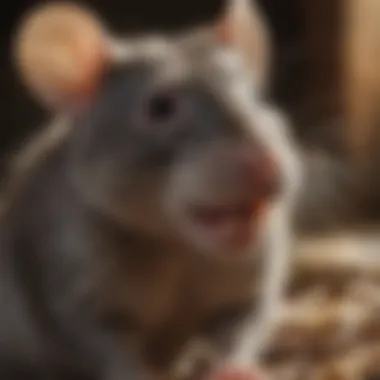

Once you identify the stressors, effective strategies can be employed to decrease anxiety levels.
- Provide a safe space: Ensure your rat has a comfortable area to retreat. This can be a cozy hideaway or nesting area.
- Enrich the environment: Add chew toys, tunnels, and climbing structures. This not only satisfies the rat's chewing instinct but also stimulates their mind.
- Social interaction: If possible, spend more time with your rat. Engage them in gentle play to foster a sense of security.
- Maintain a routine: Rats thrive on predictability. Try to keep feeding times and activity schedules consistent to reduce anxiety.
- Calming products: In some cases, using natural calming solutions or consult with a veterinarian for further assistance can help.
By minimizing stress and its manifestations in the form of chewing, both pets and owners can enjoy a more harmonious coexistence.
Understanding Rat Health and Chewing
Understanding rat health in relation to chewing behavior is crucial for pet owners and enthusiasts. Chewing serves many functions in rats. It is not merely a destructive behavior but rather an essential need that aligns with their natural instincts. Acknowledging this need can transform how we approach living with these animals. Properly addressing and understanding their chewing habits can lead to healthier pets and a more harmonious home.
Dental Health Implications
Rats have continuously growing incisors, which means they need to chew to maintain dental health. If they do not have adequate materials to gnaw on, their teeth can overgrow, leading to various health issues. Overgrown teeth can prevent proper eating, cause pain, and create other complications like infections.
- Regularly providing appropriate chewing materials helps keep their teeth trimmed.
- Materials like untreated wood, specific chew toys, and even some safe cardboard items can serve this purpose well.
- Watch for signs of dental distress, including difficulty eating, drooling, or atypical behaviors like aggression or excessive chewing on non-food items.
Taking dental health seriously ensures your pet has a healthy lifestyle. It can reduce visits to the vet and improve their overall well-being.
Nutrition's Role in Chewing Behavior
Nutrition heavily influences rat chewing behavior. Rats do not only chew for dental health; they also do it for nutritional fulfillment. The quality of their diet impacts their health and chewing habits. A diet that lacks certain nutrients can lead rats to seek alternative chewing materials.
Key aspects include:
- Balanced Diet: Ensure a diet that incorporates fruits, vegetables, and grains. These provide essential vitamins and minerals necessary for their overall health.
- Chewable Foods: Incorporate foods specifically designed for chewing. For instance, high-fiber foods stimulate gnawing, contributing to better health.
- Avoid Harmful Additives: Certain foods can be harmful, thus it’s important to avoid items that contain artificial colors or preservatives.
Addressing nutritional needs through their diet can subsequently lead to healthier chewing habits. This, in turn, results in less destructive behavior and enhances their quality of life.
"Providing a well-rounded diet and chewable materials creates a stable and enriching environment for pet rats, connecting dental health with behavioral benefits."
Common Myths About Rat Chewing
Understanding the myths surrounding rat chewing behavior is crucial for pet owners and enthusiasts. Many misconceptions can lead to unwarranted fear or misunderstanding about these animals. By debunking these myths, we foster accurate knowledge and improve the environment for pet rats in domestic settings. Clear awareness can help rat owners provide better care and prevent incidents that arise from incorrect beliefs.
Debunking Misconceptions
Several misconceptions exist about why rats chew so much. One common belief is that rats chew items out of sheer destructiveness. In fact, chewing is a natural behavior that stems from their need to gnaw. Rats have continuously growing teeth, and they need to wear them down to prevent dental issues. Here are some myths to clarify:
- Myth 1: Rats chew to destroy furniture. This assumes malicious intent, but rats do not have such motives. They chew to manage their teeth and explore their environment.
- Myth 2: Only certain breeds are destructive chewers. All rats require chewing to some degree. It is not limited to specific breeds.
- Myth 3: Chewing can be completely eliminated. While management strategies can reduce it, some chewing is inevitable. Awareness helps in providing proper outlets for this behavior.
Using chew toys and ensuring a stimulating environment can considerably lessen damage to household items. This myth-busting fosters a more humane understanding of their behavior, allowing for better care and supervision.
Rats vs. Other Rodents
When comparing rats to other rodents, such as mice or hamsters, their chewing behavior exhibits some distinct differences. Rats are known for their intelligence, which often leads to fancier habitats. Here’s how rat chewing compares:
- Dentition: Rats have larger and stronger teeth than many other rodents, which means they may cause more significant damage if not managed well.
- Behavioral Complexity: Unlike hamsters, who mainly store food, rats often use their chewing as a way of exploring and interacting with their environment. Their active curiosity drives them to chew on various materials.
- Social Learning: Rats learn from each other’s behaviors. If one rat develops a habit of chewing on a specific item, others may mimic this action. This social context in learning is less prevalent in solitary rodents like gerbils.
Understanding these differences leads to better housing strategies, accommodating their needs while reducing the potential risk of damage to property.
Awareness of chewing behavior in rats versus other rodents provides insights into creating an enriched environment. With accurate knowledge, pet owners can implement strategies tailored to the unique needs of rats, ensuring a healthy coexistence.
Case Studies on Rat Chewing
Understanding the chewing behavior of rats through real-world case studies is essential for multiple reasons. It allows pet owners and enthusiasts to comprehend the nuances and motivations that underlie this behavior. These instances can also illustrate best practices or common mistakes many make when interacting with their pets. Furthermore, case studies present data that can help develop better management strategies. By analyzing specific scenarios, one can identify patterns and potentially mitigate issues related to destructive chewing.
Analyzing Specific Instances
Evaluating various case studies reveals critical insights about why rats engage in chewing behaviors that may be problematic. One instance involved a family with a pet rat named Squeaky, who developed a habit of chewing through furniture legs. Observing Squeaky’s behavior allowed the family to pinpoint that the rat was bored and lacked adequate stimulation in his environment. After introducing more toys and climbing structures, Squeaky's furniture chewing drastically decreased. This indicates how tailored enrichment can target and reduce unwanted chewing behavior effectively.
Another case involved a household that faced repetitive destruction of electrical cords. In this situation, the owners noticed that their rat, Nibbles, would often chew cords specifically when left unoccupied. By implementing regular routine checks of their living space and securing vulnerable items, they managed to reduce the occurrence of Nibbles’ cord chewing. This demonstrates the necessity of being proactive in the prevention of damage, as well as understanding timing in your pet's behavior.
Lessons Learned from Owners
The experiences of pet owners provide valuable lessons that can aid others in navigating the challenges of rat chewing. First, many owners report that providing appropriate chew toys can significantly reduce non-destructive chewing. These toys give the rats an outlet for their natural instinct to gnaw.
Moreover, a recommendation from several owners is to establish a routine for interaction and playtime. Rats are social creatures, and insufficient interaction can lead to stress and boredom, both of which drive them to chew on various objects. Setting a daily schedule for engagement becomes essential for mental enrichment.
Furthermore, many owners highlight the importance of environmental modifications. Simple steps such as rearranging furniture or relocating valuable items can help prevent unwanted damage. Owners have also noted the effectiveness of certain deterrents that can make specific areas less appealing for chewing purposes.
In summary, case studies on rat chewing behavior uncover not just the reasons behind this natural instinct but also practical solutions that can aid in mitigating damage. By learning from the experiences of others, pet owners can cultivate a more harmonious and safe environment for their furry friends.
Closure: Coexistence with Rats
Understanding the dynamics of rat chewing behavior is crucial for ensuring harmonious relationships between pet owners and their furry companions. This article highlights various facets of rat chewing, including its physiological and psychological roots, potential impacts on domestic environments, and the significance of proactive management strategies. Through the lens of coexistence, we can better appreciate these creatures and the adaptations that allow them to thrive in human habitats.
Summary of Key Insights
Rat chewing behavior serves several essential functions in both wild and domestic settings.
- Physiological Importance: Chewing is integral for dental health, contributing to the wear and tear necessary for maintaining the length and shape of their teeth. Without adequate chewing opportunities, rats may face dental issues leading to more severe health problems.
- Behavioral Context: Chewing is not merely an instinctual action; it is a response to environmental stressors, boredom, and the need to explore their surroundings. Consequently, an understanding of their needs can lead to better care practices.
- Impact on Homes: While rat chewing might lead to damage in households, this behavior can be redirected using appropriate management techniques.
Providing enriched environments can mitigate undesirable chewing while promoting a pet's well-being and satisfaction.
Encouragement for Responsible Ownership
Responsible ownership of rats hinges on recognizing their natural behaviors and needs. Pet owners must provide adequate stimulation and safe chewing options to foster good habits. Here are a few ways to promote responsible ownership:
- Invest in Quality Chew Toys: Offering toys specifically designed for rats can satisfy their chewing instinct while protecting household items.
- Create an Enriching Environment: A stimulating habitat filled with climbing structures, tunnels, and hideaways encourages physical activity and mental engagement.
- Routine Health Monitoring: Regular checks for dental issues, dietary needs, and overall health contribute to a pet's quality of life and longevity.
"Through understanding and accommodating rat behavior, we can nurture their well-being while fostering a respectful coexistence."







